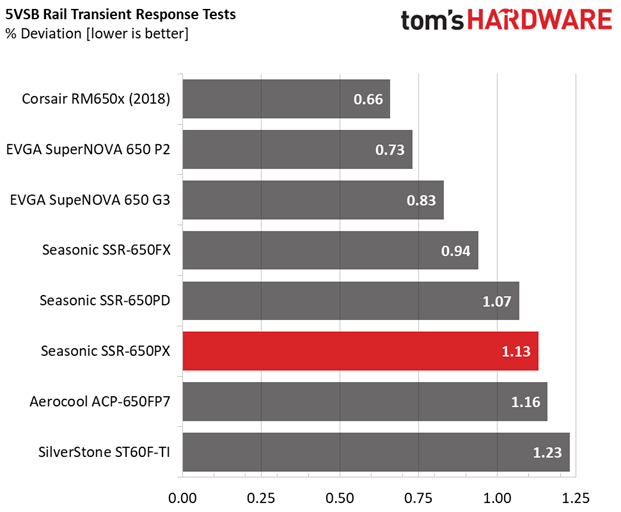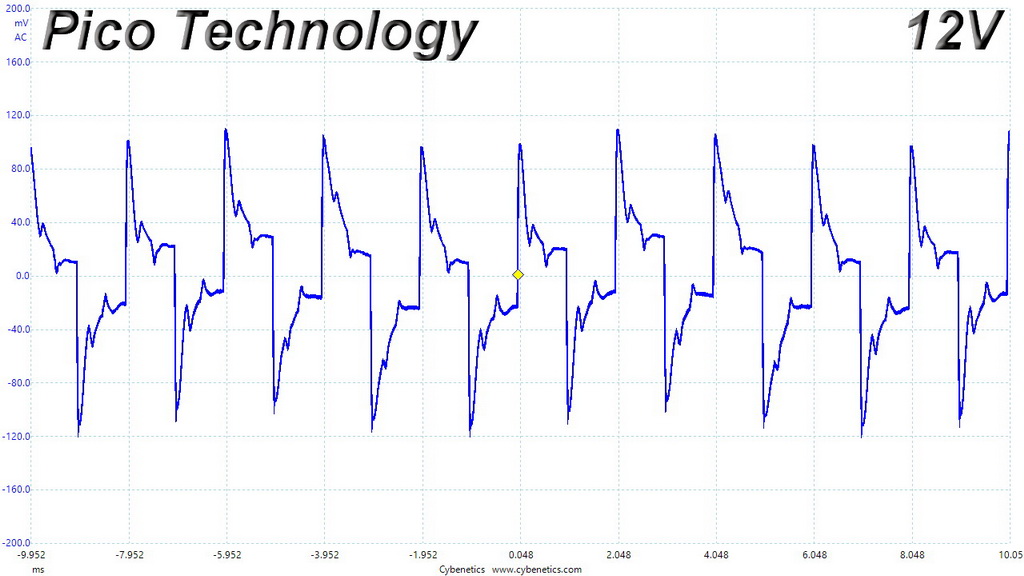Seasonic SSR-650PX PSU Review: High Performance Without Breaking The Bank
Why you can trust Tom's Hardware
Transient Response Tests
Advanced Transient Response Tests
For details on our transient response testing, please click here.
Ιn these tests, we monitor the SSR-650PX's response in several scenarios. First, a transient load (10A at +12V, 5A at 5V, 5A at 3.3V, and 0.5A at 5VSB) is applied for 200ms as the PSU works at 20 percent load. In the second scenario, it's hit by the same transient load while operating at 50 percent load.
In the next sets of tests, we increase the transient load on the major rails with a new configuration: 15A at +12V, 6A at 5V, 6A at 3.3V, and 0.5A at 5VSB. We also increase the load-changing repetition rate from 5 Hz (200ms) to 50 Hz (20ms). Again, this runs with the PSU operating at 20 and 50 percent load.
The last tests are even tougher. Although we keep the same loads, the load-changing repetition rate rises to 1 kHz (1ms).
In all of the tests, we use an oscilloscope to measure the voltage drops caused by the transient load. The voltages should remain within the ATX specification's regulation limits.
These tests are crucial because they simulate the transient loads a PSU is likely to handle (such as booting a RAID array or an instant 100 percent load of CPU/GPUs). We call these "Advanced Transient Response Tests," and they are designed to be very tough to master, especially for a PSU with a capacity of less than 500W.
The ATX spec requires capacitive loading during the transient rests, but in our methodology we chose to apply a worst-case scenario with no extra capacitance on the rails.
Get Tom's Hardware's best news and in-depth reviews, straight to your inbox.
Advanced Transient Response at 20 Percent – 200ms
| Voltage | Before | After | Change | Pass/Fail |
|---|---|---|---|---|
| 12V | 12.139V | 12.051V | 0.72% | Pass |
| 5V | 5.028V | 4.889V | 2.76% | Pass |
| 3.3V | 3.315V | 3.173V | 4.28% | Pass |
| 5VSB | 5.073V | 5.016V | 1.12% | Pass |
Advanced Transient Response at 20 Percent – 20ms
| Voltage | Before | After | Change | Pass/Fail |
|---|---|---|---|---|
| 12V | 12.139V | 12.017V | 1.01% | Pass |
| 5V | 5.028V | 4.864V | 3.26% | Pass |
| 3.3V | 3.315V | 3.145V | 5.13% | Pass |
| 5VSB | 5.073V | 5.026V | 0.93% | Pass |
Advanced Transient Response at 20 Percent – 1ms
| Voltage | Before | After | Change | Pass/Fail |
|---|---|---|---|---|
| 12V | 12.139V | 12.033V | 0.87% | Pass |
| 5V | 5.028V | 4.864V | 3.26% | Pass |
| 3.3V | 3.315V | 3.141V | 5.25% | Pass |
| 5VSB | 5.073V | 5.020V | 1.04% | Pass |
Advanced Transient Response at 50 Percent – 200ms
| Voltage | Before | After | Change | Pass/Fail |
|---|---|---|---|---|
| 12V | 12.138V | 12.056V | 0.68% | Pass |
| 5V | 5.026V | 4.880V | 2.90% | Pass |
| 3.3V | 3.312V | 3.163V | 4.50% | Pass |
| 5VSB | 5.043V | 4.986V | 1.13% | Pass |
Advanced Transient Response at 50 Percent – 20ms
| Voltage | Before | After | Change | Pass/Fail |
|---|---|---|---|---|
| 12V | 12.138V | 12.014V | 1.02% | Pass |
| 5V | 5.026V | 4.856V | 3.38% | Pass |
| 3.3V | 3.312V | 3.135V | 5.34% | Fail |
| 5VSB | 5.043V | 5.000V | 0.85% | Pass |
Advanced Transient Response at 50 Percent – 1ms
| Voltage | Before | After | Change | Pass/Fail |
|---|---|---|---|---|
| 12V | 12.138V | 12.017V | 1.00% | Pass |
| 5V | 5.026V | 4.855V | 3.40% | Pass |
| 3.3V | 3.312V | 3.138V | 5.25% | Fail |
| 5VSB | 5.043V | 4.998V | 0.89% | Pass |





Transient response on the +12V rail is good enough, though we would like to see closer to 0.5% readings. Meanwhile the minor rails, especially the 3.3V, need some tuning if Seasonic wants to keep up with its competition.
Here are the oscilloscope screenshots we took during Advanced Transient Response Testing:
Transient Response At 20 Percent Load – 200ms




Transient Response At 20 Percent Load – 20ms




Transient Response At 20 Percent Load – 1ms




Transient Response At 50 Percent Load – 200ms




Transient Response At 50 Percent Load – 20ms




Transient Response At 50 Percent Load – 1ms




Turn-On Transient Tests
In the next set of tests, we measure the SSR-650PX’s response in simpler transient load scenarios—during its power-on phase.
For our first measurement, we turn the SSR-650PX off, dial in the maximum current the 5VSB rail can handle, and switch the PSU back on. In the second test, we dial the maximum load the +12V rail can handle and start the PSU while it is in standby mode. In the last test, while the PSU is completely switched off, we dial the maximum load the +12V rail can handle before restoring power. The ATX specification states that recorded spikes on all rails should not exceed 10 percent of their nominal values (+10 percent for 12V is 13.2V, and 5.5V for 5V).



We observe a tiny voltage overshoot at 5VSB and almost perfect slopes at +12V. Our turn-on transient tests reveal very good performance.
MORE: Best Power Supplies
MORE: How We Test Power Supplies
MORE: All Power Supply Content
Current page: Transient Response Tests
Prev Page Cross-Load Tests & Infrared Images Next Page Ripple Measurements
Aris Mpitziopoulos is a contributing editor at Tom's Hardware, covering PSUs.
-
DookieDraws I won't put anything in my builds, or builds I do for others, other than a Seasonic PSU. Used them for years and have never had any issues. Not saying there isn't any other reliable brands out there, as I know there are, but I'm sticking with what has worked for me.Reply -
mlee 2500 What a Coincidence! I bought this very same Seasonic 650PX Power Supply and just last night finally took it out of the box to prep for my new build...and here I find a review for it!!Reply
The author makes an excellent point that a 2nd modular EPS cable really should be standard these days. With motherboards now supporting USB 3.1, integrated WiFi, a whole slew of 2A fan/pump connectors and tons of other power-drawing features which hardly even existed a decade ago, a second EPS is quickly becoming the norm rather then the exception.
In my case, with the very popular ASrock Taichi Z series motherboards which requires three connectors (1x24, 1x8, 1x4), I need to obtain a second additional 8pin to 2x4 modular cable. I just happened to contact Seasonic about that not an hour before seeing this review and learned that www.btosinte.com is their approved distributor and that such a cable costs about $5.00
If you do need to buy an additional EPS cable, BE SURE TO GET THE ONE WITH THE INLINE CAPACITOR, for the newer SSR series!!
It was interesting to learn from this article that providing a second EPS cable isn't really typical for most vendors 650W power supplies, which makes me feel better about being in that predicament with Seasonic. I was initially a bit disappointed, but then I've never had a Desktop mobo which required so many connectors before.
All that being said this appears to be an outstanding power supply, a great value, and given that my previous modular Seasonic Power Supply is still running great after more then 6 years, I remain a Seasonic customer until proven I shouldn't be. -
Aris_Mp I am insisting for quite some time for a second EPS connectors in high-end PSUs and your post clearly shows why. Thank you!Reply